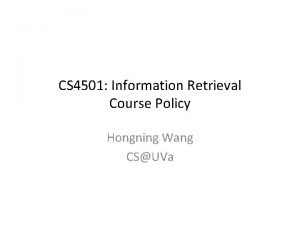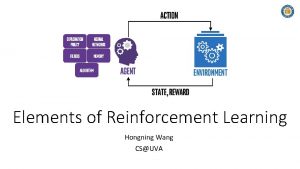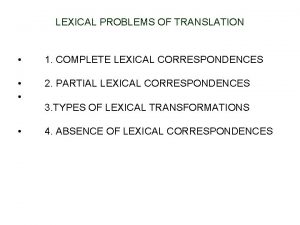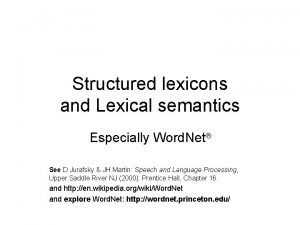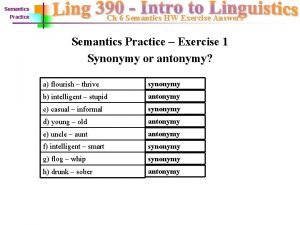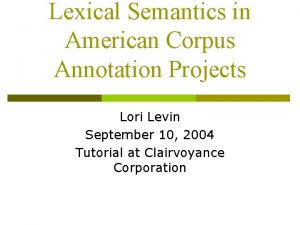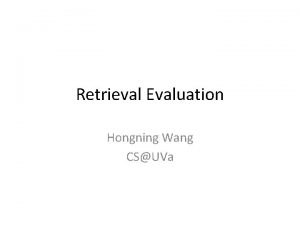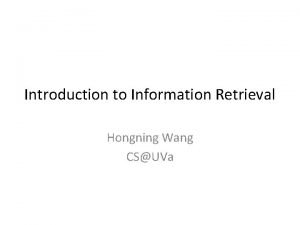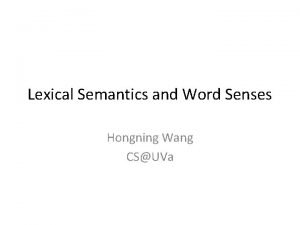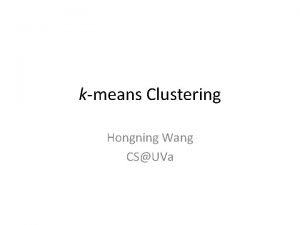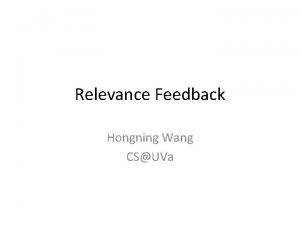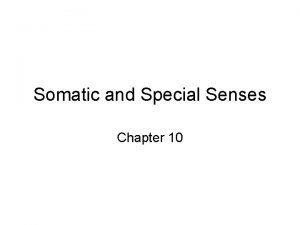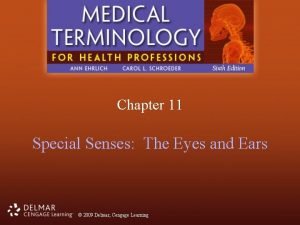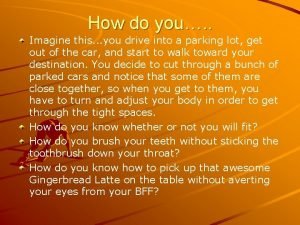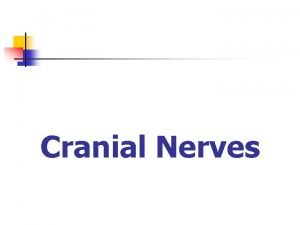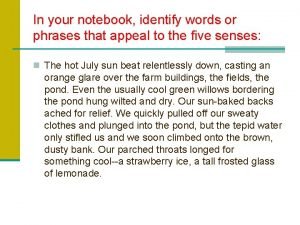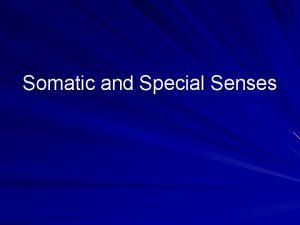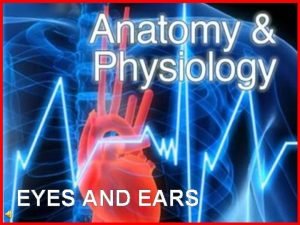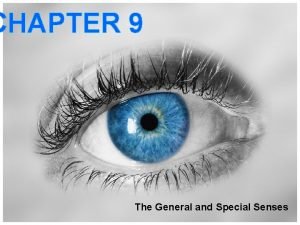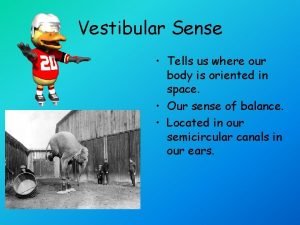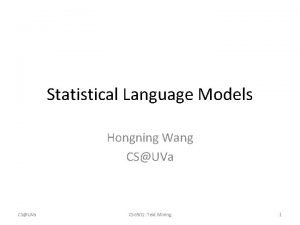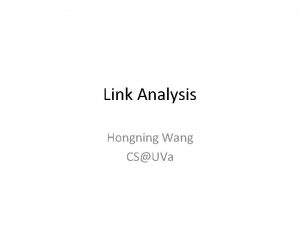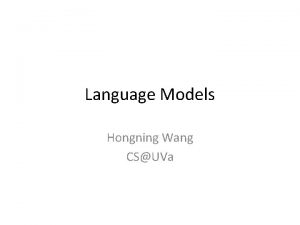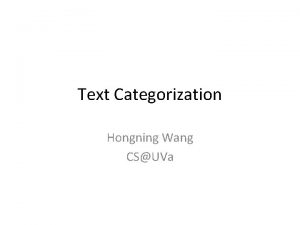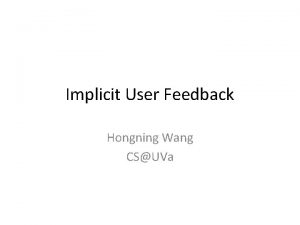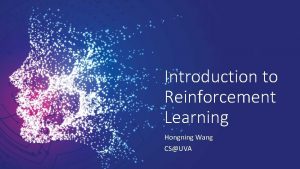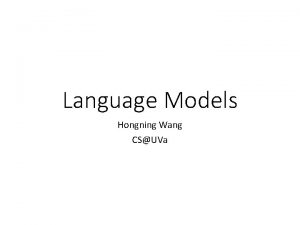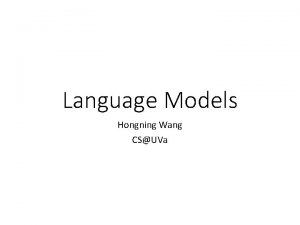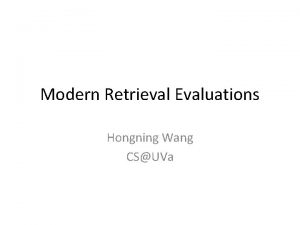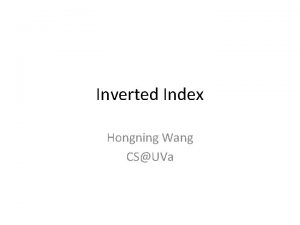Lexical Semantics and Word Senses Hongning Wang CSUVa




































- Slides: 36

Lexical Semantics and Word Senses Hongning Wang CS@UVa

Today’s lecture 1. Lexical semantics – Meaning of words – Relation between different meanings 2. Word. Net – An ontology structure of word senses – Similarity between words 3. Distributional semantics – Similarity between words – Word sense disambiguation CS@UVa CS 6501: Text Mining 2

What is the meaning of a word? • Most words have many different senses – dog = animal or sausage? – lie = to be in a horizontal position or a false statement made with deliberate intent • What are the relations of different words in terms of meaning? – Specific relations between senses • Animal is more general than dog – Semantic fields • Money is related to bank CS@UVa “a set of words grouped, referring to a specific subject … not necessarily synonymous, but are all used to talk about the same general phenomenon ” - wiki CS 6501: Text Mining 3

Word senses • What does ‘bank’ mean? – A financial institution • E. g. , “US bank has raised interest rates. ” – A particular branch of a financial institution • E. g. , “The bank on Main Street closes at 5 pm. ” – The sloping side of any hollow in the ground, espe cially when bordering a river • E. g. , “In 1927, the bank of the Mississippi flooded. ” – A ‘repository’ • E. g. , “I donate blood to a blood bank. ” CS@UVa CS 6501: Text Mining 4

Lexicon entries lemma senses CS@UVa CS 6501: Text Mining 5

Some terminologies • Word forms: runs, ran, running; good, better, best – Any, possibly inflected, form of a word • Lemma (citation/dictionary form): run; good – A basic word form (e. g. infinitive or singular nominative noun) that is used to represent all forms of the same word • Lexeme: RUN(V), GOOD(A), BANK 1(N), BANK 2(N) – An abstract representation of a word (and all its forms), with a part-of-speech and a set of related word senses – Often just written (or referred to) as the lemma, perhaps in a different FONT • Lexicon – A (finite) list of lexemes CS@UVa CS 6501: Text Mining 6

Make sense of word senses • Polysemy – A lexeme is polysemous if it has different related senses bank = financial institution or a building CS@UVa CS 6501: Text Mining 7

Make sense of word senses • Homonyms – Two lexemes are homonyms if their senses are unrelated, but they happen to have the same spelling and pronunciation bank = financial institution or river bank CS@UVa CS 6501: Text Mining 8

• Take the highest scoring entry in the last Keep backpointers in each trellis to keep column of the trellis track of the most probable sequence CS@UVa CS 6501: Text Mining 9

Recap: comparing to traditional classification problems Sequence labeling Traditional classification • • CS@UVa CS 6501: Text Mining 10

Recap: generative V. S. discriminative models • Binary classification as an example Generative Model’s view CS@UVa Discriminative Model’s view CS 6501: Text Mining 11

Recap: maximum entropy Markov models • CS@UVa CS 6501: Text Mining 12

• CS@UVa CS 6501: Text Mining 13

Recap: what is the meaning of a word? • Most words have many different senses – dog = animal or sausage? – lie = to be in a horizontal position or a false statement made with deliberate intent • What are the relations of different words in terms of meaning? – Specific relations between senses • Animal is more general than dog – Semantic fields • Money is related to bank CS@UVa “a set of words grouped, referring to a specific subject … not necessarily synonymous, but are all used to talk about the same general phenomenon ” - wiki CS 6501: Text Mining 14

Relations between senses • Symmetric relations – Synonyms: couch/sofa • Two lemmas with the same sense – Antonyms: cold/hot, rise/fall, in/out • Two lemmas with the opposite sense • Hierarchical relations: – Hypernyms and hyponyms: pet/dog • The hyponym (dog) is more specific than the hypernym (pet) – Holonyms and meronyms: car/wheel • The meronym (wheel) is a part of the holonym (car) CS@UVa CS 6501: Text Mining 15

Word. Net George Miller, Cognitive Science Laboratory of Princeton University, 1985 • A very large lexical database of English: – 117 K nouns, 11 K verbs, 22 K adjectives, 4. 5 K adverbs • Word senses grouped into synonym sets (“synsets”) linked into a conceptual-semantic hierarchy – 82 K noun synsets, 13 K verb synsets, 18 K adjectives synsets, 3. 6 K adverb synsets – Avg. # of senses: 1. 23/noun, 2. 16/verb, 1. 41/adj, 1. 24/adverb • Conceptual-semantic relations – hypernym/hyponym CS@UVa CS 6501: Text Mining 16

A Word. Net example • http: //wordnet. princeton. edu/ CS@UVa CS 6501: Text Mining 17

Hierarchical synset relations: nouns • Hypernym/hyponym (between concepts) – The more general ‘meal’ is a hypernym of the more specific ‘breakfast’ • Instance hypernym/hyponym (between concepts and instances) Jane Austen, 1775– 1817, English novelist – Austen is an instance hyponym of author • Member holonym/meronym (groups and members) – professor is a member meronym of (a university’s) faculty • Part holonym/meronym (wholes and parts) – wheel is a part meronym of (is a part of) car. • Substance meronym/holonym (substances and components) – flour is a substance meronym of (is made of) bread CS@UVa CS 6501: Text Mining 18

Word. Net hypernyms & hyponyms CS@UVa CS 6501: Text Mining 19

Hierarchical synset relations: verbs the presence of a ‘manner’ relation between two lexemes • Hypernym/troponym (between events) – travel/fly, walk/stroll – Flying is a troponym of traveling: it denotes a specific manner of traveling • Entailment (between events): – snore/sleep • Snoring entails (presupposes) sleeping CS@UVa CS 6501: Text Mining 20

Word. Net similarity • Path based similarity measure between words – Shortest path between two concepts (Leacock & Chodorow 1998) • sim = 1/|shortest path| – Path length to the root node from the least common subsumer (LCS) of the two concepts (Wu the most specific concept which is & Palmer 1994) an ancestor of both A and B. • sim = 2*depth(LCS)/(depth(w 1)+depth(w 2)) • http: //wn-similarity. sourceforge. net/ CS@UVa CS 6501: Text Mining 21

Word. Net: : Similarity CS@UVa CS 6501: Text Mining 22

Word. Net: : Similarity CS@UVa CS 6501: Text Mining 23

Distributional hypothesis • What is tezgüino? – A bottle of tezgüino is on the table. – Everybody likes tezgüino. – Tezgüino makes you drunk. – We make tezgüino out of corn. • The contexts in which a word appears tell us a lot about what it means CS@UVa CS 6501: Text Mining 24

Distributional semantics • CS@UVa CS 6501: Text Mining 25

How to define the context within a sentence • CS@UVa CS 6501: Text Mining 26

Mutual information • CS@UVa CS 6501: Text Mining 27

Pointwise mutual information within a sentence • CS@UVa CS 6501: Text Mining 28

Word sense disambiguation • What does this word mean? watered – This plant needs to be watered each day. • living plant manufactures – This plant manufactures 1000 widgets each day. • factory • Word sense disambiguation (WSD) – Identify the sense of content words (noun, verb, adjective) in context (assuming a fixed inventory of word senses) CS@UVa CS 6501: Text Mining 29

Dictionary-based methods • A dictionary/thesaurus contains glosses and examples of a word bank 1 Gloss: a financial institution that accepts deposits and channels the money into lending activities Examples: “he cashed the check at the bank”, “that bank holds the mortgage on my home” bank 2 Gloss: sloping land (especially the slope beside a body of water) Examples: “they pulled the canoe up on the bank”, “he sat on the bank of the river and watched the current” CS@UVa CS 6501: Text Mining 30

Lesk algorithm • Compare the context with the dictionary definition of the sense context words – Construct the signature of a word in context by the signatures of its senses in the dictionary • Signature = set of context words (in examples/gloss or in context) – Assign the dictionary sense whose gloss and examples are the most similar to the context in which the word occurs • Similarity = size of intersection of context signature and sense signature CS@UVa CS 6501: Text Mining 31

Sense signatures bank 1 Gloss: a financial institution that accepts deposits and channels the money into lending activities Examples: “he cashed the check at the bank”, “that bank holds the mortgage on my home” Signature(bank 1) = {financial, institution, accept, deposit, channel, money, lend, activity, cash, check, hold, mortgage, home} bank 2 Gloss: sloping land (especially the slope beside a body of water) Examples: “they pulled the canoe up on the bank”, “he sat on the bank of the river and watched the current” Signature(bank 1) = {slope, land, body, water, pull, canoe, sit, river, watch, current} CS@UVa CS 6501: Text Mining 32

Signature of target word “The bank refused to give me a loan. ” • Simplified Lesk – Words in context – Signature(bank) = {refuse, give, loan} • Original Lesk – Augmented signature of the target word – Signature(bank) = {refuse, reject, request, . . . , give, gift, donate, . . . loan, money, borrow, . . . } CS@UVa CS 6501: Text Mining 33

Learning-based Methods • Will be discussed in the lecture of “Text Categorization” – Basically treat each sense as an independent class label – Construct classifiers to assign each instance with context into the classes/senses CS@UVa CS 6501: Text Mining 34

What you should know • Lexical semantics – Relationship between words – Word. Net • Distributional semantics – Similarity between words – Word sense disambiguation CS@UVa CS 6501: Text Mining 35

Today’s reading • Speech and Language Processing – Chapter 19: Lexical Semantics – Chapter 20: Computational Lexical Semantics CS@UVa CS 6501: Text Mining 36
 Hongning wang
Hongning wang Hongning wang
Hongning wang Hongning wang
Hongning wang Hongning wang
Hongning wang Hongning wang
Hongning wang What is the difference between somatic and special senses
What is the difference between somatic and special senses General senses vs special senses
General senses vs special senses Multiple senses of lexical items
Multiple senses of lexical items Lexical problems in translation
Lexical problems in translation Difference between grammatical and lexical meaning
Difference between grammatical and lexical meaning Compare procedural semantics and declarative semantics.
Compare procedural semantics and declarative semantics. Lexicon semantics
Lexicon semantics Semantics exercises
Semantics exercises Lexical semantics
Lexical semantics Computational lexical semantics
Computational lexical semantics Csuva
Csuva Csuva
Csuva Csuva
Csuva Csuva
Csuva Csuva
Csuva Vector space modeling
Vector space modeling Csuva
Csuva Search engine architecture
Search engine architecture Kl divergence
Kl divergence 5 elements and 5 senses
5 elements and 5 senses Thermoreceptors
Thermoreceptors Medical terminology chapter 11 learning exercises answers
Medical terminology chapter 11 learning exercises answers Anatomy and physiology chapter 8 special senses
Anatomy and physiology chapter 8 special senses Facts about taste
Facts about taste Kinesthetic sense driving
Kinesthetic sense driving Cranial nerves for special senses
Cranial nerves for special senses In your notebook identify the function
In your notebook identify the function Ear bone structure
Ear bone structure Somatic and special senses
Somatic and special senses Special senses the eyes and ears
Special senses the eyes and ears The general and special senses chapter 9
The general and special senses chapter 9 Vestibular sense
Vestibular sense
